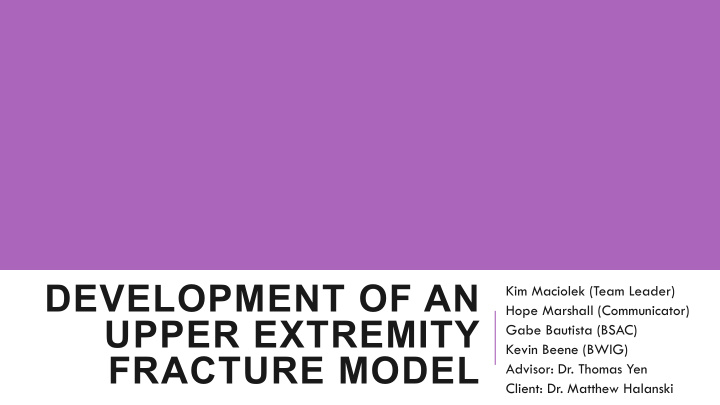



DEVELOPMENT OF AN Kim Maciolek (Team Leader) Hope Marshall (Communicator) UPPER EXTREMITY Gabe Bautista (BSAC) Kevin Beene (BWIG) FRACTURE MODEL Advisor: Dr. Thomas Yen Client: Dr. Matthew Halanski
PROBLEM STATEMENT o Teach proper and safe techniques of fracture reduction and immobilization throughout the process of cast application and removal using a forearm fracture simulator o Forearm fracture simulator must provide immediate feedback to the user to monitor fracture reduction: o Bone alignment o Applied force (three-point molding, cast saw) o Temperature at skin surface
CLIENT DESCRIPTION o Dr. Matthew Halanski o Pediatric orthopedic surgeon at UW Hospital & Clinics o Research interest in safe fracture reduction
DESIGN CONSTRAINTS Forearm fracture simulator must: o Mimic the size of pediatric forearm (18 cm long, 5 cm wide) o Protect sensors for damage by the saw o Measure & display temperature, pressure & alignment in real time o Clearly indicate successful fracture reduction o <15 o angulation o <2 mm displacement
MOTIVATION o 1/3 of children will suffer a fracture, f orearms most common (Hedström. Acta Orthopaedica 2010; 81(1):148–153) o Casting is not always safe! o Cast accidents are #1 cause of litigation, each can cost up to $120,000 (Killian, J of Ped Ortho. 1999. 19(5): 683-7) o Little formal, hands on training for residents Figure 1: Cast saw burns (courtesy of Dr. Halanski).
CURRENT DEVICES Figure 2: Client’s prototype (courtesy of Dr. Halanski).
PRELIMINARY PROTOTYPE
CURRENT PROTOTYPE Child’s Protective Arm Sleeve forearm held in place Thermistors Cast Pressure Mapping System
EVALUATION AND TESTING o Latex Tubing - Modulation of Resistance - MTS Testing o To failure o Static testing o Tension: cycles of stretching bands 0%-30% o Temperature sensors o Alignment and Pressure Sensors: Cast Index and X-Ray Verification o Accuracy o Precision o Effectiveness of the device as a learning tool o Each person is own control o Test, practice, retest o Evaluate improvement over time
TIMELINE • 3/01 Modular mechanical components & flex sensor integration • 3/15 Soft tissue incorporation • 3/22 Pressure mapping system integration, Construction • 4/01 Update user interface • 4/12 Validate sensitivity with expert users • 4/26 New user testing, teaching model Evaluation
DESIGN IMPROVEMENTS o Accessible internal components o Modulate resistance in multiple plains o User manual including maintenance instructions & safety warnings o Additional surgical tubes with instructions about fatigue o Replacement skin layers after damage o All components easily removable from board & able to rotate o Components easily transported in a small box plus board
FUTURE COST ANALYSIS Additional Materials ¡ Quantity ¡ Cost Estimate ¡ Thermistors ¡ 12 ¡ $13.00 ¡ PlatSil Gel-10 ¡ 4 lbs ¡ $50.00 ¡ Flex Sensors ¡ 6 ¡ $75.00 ¡ Pressure Mapping system ¡ $10,225 ¡ 1 ¡ $30 ¡ Miscelaneous Mechanical - ¡ and electrical Components ¡ TOTAL: ¡ $10,393.00 ¡
CURRENT COST ANALYSIS Material ¡ Cost ¡ Quantity ¡ Plywood Base ¡ 1 ¡ $5 ¡ PVC Pipes ¡ 1 ¡ $1.25 ¡ Thermistor ¡ 3 ¡ $3.24 ¡ Force Sensing Resistor ¡ 1 ¡ $20 ¡ Arduino Mega Microcontroller ¡ 1 ¡ $47.99 ¡ Arduino Starter kit ¡ 1 ¡ $22.50 ¡ Protective Sleeve material ¡ 48”x 84” ¡ $7.85 ¡ PDMS ¡ 500 grams ¡ $60 ¡ PlatSil Gel-10 ¡ 6 lbs ¡ $100 ¡ USB A-B Cable ¡ 1 ¡ $4.00 ¡ 1/4” ID Latex Surgical Tubing ¡ 17’ ¡ $36.00 ¡ Prewrap material ¡ 1 roll ¡ $5 ¡ Flex Sensor ¡ 2 ¡ $24.90 ¡ Miscelaneous Mech. Components ¡ - ¡ $0 ¡ TOTAL: ¡ $330.50 ¡
QUESTIONS?
Recommend
More recommend